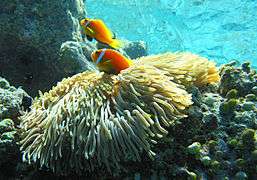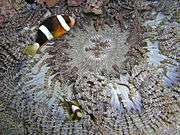Stichodactylidae
| Stichodactylidae | |
|---|---|
 | |
| Heteractis magnifica with Maldive anemonefish and juvenile Threespot dascyllus. | |
| Scientific classification | |
| Kingdom: | Animalia |
| Phylum: | Cnidaria |
| Class: | Anthozoa |
| Subclass: | Hexacorallia |
| Order: | Actiniaria |
| Family: | Stichodactylidae Andres, 1883 |
| Genera | |
Stichodactylidae is a family of sea anemones that contains the genera Stichodactyla (carpet anemones) and Heteractis. These sea anemones are exclusively tropical and are in the main family of sea anemones that hosts several varieties of clownfishes.[1] Most sea anemone species are harmless to humans, but at least some Stichodactyla are highly venomous and their sting may cause anaphylactic shock and organ failure (notably acute liver failure).[2][3] In contrast, the venom of Heteractis has shown potential in treatment of lung cancer.[4]
- Genus: Heteractis
- Genus: Stichodactyla (carpet anemones)
Gallery
 Stichodactyla tapetum
Stichodactyla tapetum Heteractis aurora
Heteractis aurora
References
- ↑ Fautin, Daphne G.; Allen, Gerald R. (1997). Field Guide to Anemone Fishes and Their Host Sea Anemones. Western Australian Museum. ISBN 9780730983651. Archived from the original on 14 April 2015.
- ↑ Garcia, P.J.; Schein, R.M.; and Burnett, J.W. (1994). Fulminant hepatic failure from a sea anemone sting. Ann. Intern. Med. 120: 665–666.
- ↑ Nagata, K.; Hide, M.; Tanaka, T.; Ishii, K.; Izawa, M.; Sairenji, T.; Tomita, K.; and Shimizu, E. (2006). Anaphylactic shock caused by exposure to sea anemones. Allergol. Int. 55: 181–184.
- ↑ Ramezanpour, M.; da Silva, K.B.; and Sanderson, B.J. (2014). Venom present in sea anemone (Heteractis magnifica) induces apoptosis in non-small-cell lung cancer A549 cells through activation of mitochondria-mediated pathway. Biotechnol Lett. 36(3): 489-495.
This article is issued from
Wikipedia.
The text is licensed under Creative Commons - Attribution - Sharealike.
Additional terms may apply for the media files.